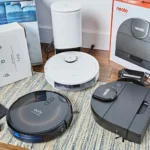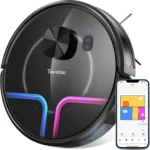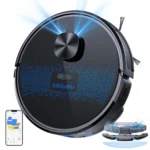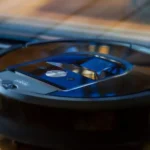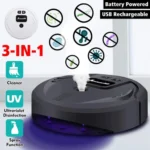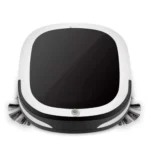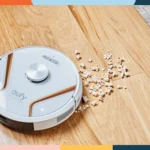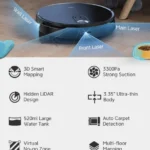Are you tired of spending your weekends vacuuming your house? Or are you looking for a more effective and efficient way to keep your floors clean? A smart vacuum cleaner might just be the solution you’re looking for! But with so many features and models available, how do you know which one to choose?
In this article, we will explore the top features to consider when comparing smart vacuum cleaner designs. From navigation systems to dustbin capacity to mapping technology, we’ve got you covered. So, sit back, relax, and let’s dive into the world of smart vacuum cleaners.
Essential Features of Smart Vacuum Cleaners
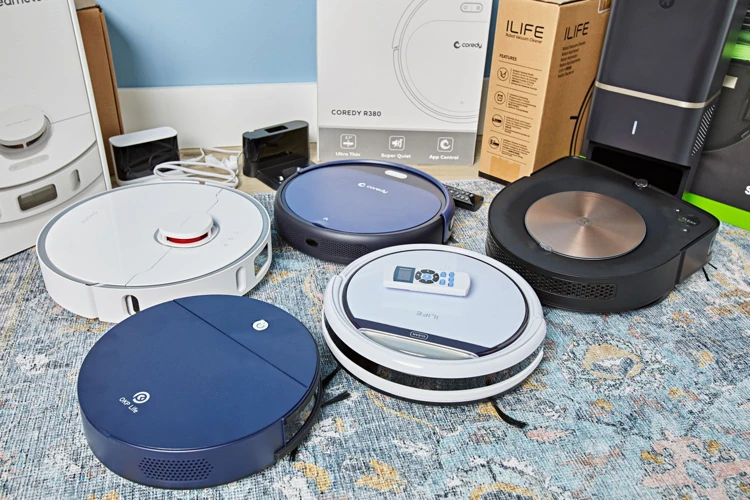
When selecting a smart vacuum cleaner, there are certain key features that you need to consider in order to ensure that you’re investing in a device that will meet your expectations. These devices are designed to clean floors autonomously, using technology to navigate around furniture and collect dust and debris, without the need for you to intervene. In this section, we’ll take an in-depth look at the essential features that you need to compare when selecting a smart vacuum cleaner. It’s important to keep these features in mind when considering which product to purchase, as it can make a huge difference in how effectively the vacuum cleaner functions. Let’s take a look at what you should be looking for. If you want to learn about smart vacuum design elements in general, you can also do it by clicking on this link.
1. Navigation System
The navigation system is one of the essential features to consider when comparing smart vacuum cleaner designs. It’s crucial that a vacuum cleaner moves intelligently around your home to ensure that it covers all the areas that require cleaning.
Navigation systems use different technologies to map out the cleaning areas, such as infrared sensors, laser sensors, and cameras. These sensors allow the vacuum cleaner to navigate and create a map of your home, which it can follow to move from one area to another.
Some smart vacuum cleaners also use unseen designs that enable them to navigate without bumping into obstacles, which makes them an excellent choice for homes with many furniture and delicate items.
Here is an overview of the main navigation systems that smart vacuum cleaners use:
| Navigation System | Description |
|---|---|
| Infrared | This system uses infrared sensors to detect obstacles and walls. It’s not as advanced as laser sensors, but it’s more affordable. |
| Laser | This system uses laser sensors that spin around, mapping out the area around the vacuum cleaner quickly. It’s sophisticated and accurate. |
| Camera | Some vacuum cleaners have a camera installed, which allows them to create a visual map of your home. This system is still new, and it may need some improvement. |
When selecting a smart vacuum cleaner, it’s essential to consider the navigation system it uses, how it navigates, and how it deals with obstacles. You may also want to consider the pros and cons of different smart vacuum styles to ensure you select the one that matches your cleaning needs. Additionally, you may want to read up on smart vacuum design tips for insight on selecting the best smart vacuum cleaner for your home.
2. Suction Power
When it comes to selecting a smart vacuum cleaner, one of the most important features to consider is the suction power. This is what separates a good smart vacuum cleaner from an average one. Here are some key points to consider when evaluating the suction power:
- Suction Power – The strength of the suction motor is a key factor in how well the vacuum cleaner performs on your floors. It determines how well it can pick up dirt, pet hair and other debris. Vacuums with higher suction power can pick up more dirt and debris with greater ease. However, keep in mind that the suction power required may depend on the type of flooring in your home. For example, a vacuum with a high suction power might be too powerful for some delicate floorings like hardwood floors, and might cause damage.
- Motorized Brush – A motorized brush is a great accessory to have in your smart vacuum cleaner. It can pick up dirt and pet hair from carpets more effectively than a suction-only vacuum. The motorized brush also agitates the carpet fibers, which makes it easier for the vacuum to pick up dirt that might be embedded in the carpet fibers.
- Adjustable Suction Power – While high suction power is great for deep cleaning carpets, it may not be necessary for hard floors. An adjustable suction power allows you to customize the suction strength according to the type of flooring you are cleaning. This not only enhances the cleaning performance but also helps save energy.
- Filtration System – Suction power also plays a role in the performance of the filtration system. The strength of the motor is directly related to the airflow; the stronger the motor, the more air is moving through the machine. A stronger airflow helps improve the filtration capabilities of the vacuum by ensuring that more air and dust are drawn into the filter. A stronger filtration system is especially important for people with allergies or respiratory problems.
- Noise Level – Higher suction power typically leads to more noise, as the motor has to work harder to maintain the suction level. If noise is a concern, it’s important to look for a vacuum cleaner with a lower decibel rating.
Consider all these factors when comparing smart vacuum cleaners. While suction power is an important factor, it’s only a part of the overall picture. A smart vacuum cleaner’s performance is a combination of the strength of its suction motor, its filtration system and other features like its brush system, battery life, and navigation system.
3. Run Time and Recharging Time
One of the most important factors to consider when comparing smart vacuum cleaners is their run time and recharging time. In general, the longer the run time, the more area the vacuum can cover before needing to be recharged.
When it comes to run time, the average for most robot vacuums is around 60 to 90 minutes. However, some high-end models offer a run time of up to 120 minutes. If you have a large home, you might want to consider a vacuum with a longer run time to ensure that it can cover all the areas you want it to.
Recharging time is also an essential factor to keep in mind. The amount of time it takes for the vacuum to recharge can vary depending on the model. On average, most vacuums take around 3 to 4 hours to recharge fully. Still, some models can take as little as 1 hour, while others can take up to 5 hours. It’s crucial to consider the downtime when you plan to use your vacuum daily.
It’s essential to look for models that have a quick charge feature that enables them to recharge relatively quickly. This way, even if the vacuum runs out of battery in the middle of cleaning, it can recharge fast and finish the job.
The table below summarizes some of the most popular smart vacuum models in terms of their run time and recharging time.
| Vacuum Model | Run Time | Recharging Time |
|---|---|---|
| iRobot Roomba 980 | 120 minutes | 120 minutes |
| Ecovacs Deebot N79S | 100 minutes | 3-4 hours |
| Shark IQ Robot Vacuum | 90 minutes | 3-4 hours |
| Eufy RoboVac 11S Max | 100 minutes | 5 hours |
As you can see from the table, the iRobot Roomba 980 has an impressive run time, but it also takes longer to recharge. It’s important to weigh the pros and cons of each model to decide which is best for your needs.
4. Dustbin Capacity
When it comes to smart vacuum cleaners, the dustbin capacity is an important feature to consider. A larger dustbin capacity means that the vacuum cleaner can clean for longer periods of time without needing to be emptied, making it more efficient and convenient for the user.
However, a larger dustbin may also increase the overall size and weight of the vacuum cleaner. It is important to find a balance between a sufficient dustbin capacity and a compact design that can easily navigate around furniture and tight spaces.
Below is a table outlining the dustbin capacity of popular smart vacuum cleaner models:
| Brand | Model | Dustbin Capacity |
|---|---|---|
| iRobot | Roomba i7+ | 0.7 liters |
| Shark | IQ Robot | 0.45 liters |
| Ecovacs | Deebot N79S | 0.52 liters |
| Xiaomi | Roborock S6 MaxV | 0.46 liters |
It is important to note that the dustbin capacity may also depend on the type of flooring in the area being cleaned. For example, homes with predominantly carpeted floors may require a larger dustbin capacity due to the amount of dust and debris that can accumulate.
When comparing smart vacuum cleaner designs, it is crucial to consider the dustbin capacity as it directly affects the vacuum cleaner’s efficiency and overall performance.
5. Compatibility with Smart Home Assistant Devices
Smart home assistant devices have revolutionized the way we live, and smart vacuum cleaners are no exception. When comparing smart vacuum cleaner designs, it’s important to consider their compatibility with these devices to fully utilize their potential. Let’s take a look at some of the key features of smart vacuum cleaners’ compatibility with smart home assistant devices.
| Compatibility | Explanation |
|---|---|
| Amazon Alexa and Google Assistant compatibility | Integration with Amazon Alexa or Google Assistant allows you to control your smart vacuum cleaner with your voice. You can also use these services to schedule cleaning sessions or check the robot’s battery life. |
| IFTTT compatibility | IFTTT (If This Then That) allows you to automate tasks between products and apps based on conditional statements. For example, you can set your smart vacuum cleaner to start cleaning when you leave your home. |
| Smartphone app compatibility | Most smart vacuum cleaners come with a dedicated smartphone app that allows you to control the robot, schedule cleaning sessions, and check its status from anywhere with an internet connection. |
| Integration with other smart home devices | Compatibility with other smart home devices such as smart locks or sensors, allows for seamless automation of household tasks. For example, you can set your smart vacuum cleaner to start cleaning when your smart lock detects that you’ve left your home. |
Having a smart vacuum cleaner that is compatible with smart home assistant devices can make cleaning more convenient and efficient. It’s essential to compare the compatibility features of different smart vacuum cleaner designs to find the one that will work best with your smart home setup.
6. Filtration System
When considering a smart vacuum cleaner, it’s important to pay attention to the filtration system. This is especially true for those with allergies or respiratory conditions who are particularly sensitive to dust and other allergens. Here are some essential things to look for in a vacuum cleaner’s filtration system:
- High-Efficiency Particulate Air (HEPA) Filter: A HEPA filter can trap over 99% of small particles, such as dust, pollen, and pet dander, making it an essential feature for anyone with allergies or respiratory conditions.
- Multi-Stage Filtration: Some smart vacuum cleaners come with a multi-stage filtration system that captures small and large particles. This includes a pre-filter, a HEPA filter, and sometimes even a carbon filter to reduce odors.
- Washable Filters: Some smart vacuum cleaners come with filters that can be washed and reused. This can save you money in the long run and reduce waste.
- Anti-Allergen Seal Technology: Some vacuum cleaners boast anti-allergen seal technology, which ensures that dust and particles don’t escape the vacuum, making it a great option for those with allergies or respiratory conditions.
When choosing a smart vacuum cleaner, look for ones that use HEPA filters or have a multi-stage filtration system with washable filters. Additionally, if you or anyone in your household suffers from allergies or respiratory issues, consider a vacuum cleaner with anti-allergen seal technology for optimal results. By choosing a vacuum with a good filtration system, you can ensure that the air in your home remains clean and healthy.
7. Noise Level
When selecting a smart vacuum cleaner, it’s essential to consider the noise level it produces during operation. A loud vacuum can cause disruptions and inconvenience in your home, especially if you like to use it during busy hours of the day. Here are some key points to consider:
- Noise Level: Look for a vacuum cleaner that operates at 60 decibels or lower. This noise level is usually quieter than a conversation between two people and won’t disturb you or anyone else in the room. Keep in mind that some smart vacuums may operate at higher noise levels when you use their more powerful suction options, so always check the noise level at different suction settings.
- Noise Control: If you opt for a vacuum that operates above 60 decibels, look for models with noise control features such as soundproofed motors, insulated canisters, and dampening technology. These features can help to reduce the noise level emitted, making operation quieter.
- Customized Schedules and Remote Operation: Look for vacuums with the option to schedule or control the cleaner remotely. You can set the vacuum to start cleaning when you’re out of the house or during times when the noise won’t be a nuisance. This feature allows you to take advantage of optimal cleaning times without being restricted by the noise level.
- Quiet Cleaning Modes: Look for vacuums with quiet cleaning modes, especially if you have children, pets or you’re sensitive to noise. Quiet cleaning modes are designed to operate at a lower noise level without compromising on cleaning power. They’re the perfect option for nighttime cleaning or when others are in the house.
By considering these noise-related features, you can enjoy a peaceful and hassle-free cleaning experience with your smart vacuum cleaner.
8. Brush System
When looking for a smart vacuum cleaner, considering the brush system is important for efficient cleaning. Here are some brushes to look for:
- Roller Brush: This brush is great for removing dirt and debris from carpets. It has bristles that penetrate deep into carpet fibers and picks up dust, pet hair, and dirt.
- Bristle Brush: A bristle brush is designed to clean hard floors. It has stronger and rougher bristles that can sweep dirt and debris from the floor.
- Side Brushes: These are brushes located on the side of the vacuum cleaner. They are usually used to sweep dirt and debris away from walls, furniture, and edges. They are also great for picking up pet hair and dirt from corners.
It’s important to consider the type of brush system a smart vacuum cleaner has, as it plays a major role in its cleaning effectiveness. A good brush system will ensure that all dirt, dust, and debris are swept up from the floor, leaving it clean and spotless.
When choosing a smart vacuum cleaner, look out for the type of brush system it has and ensure it corresponds with your flooring. A vacuum cleaner with a roller brush is ideal for carpeted floors, while one with a bristle brush is perfect for hard floors.
The brush system is an essential aspect of a smart vacuum cleaner that should not be overlooked. Having a vacuum cleaner with the appropriate brush system for your flooring will ensure thorough cleaning and leave your home looking and feeling clean.
Additional Features to Consider
As you search for the perfect smart vacuum cleaner, you’ll notice that many models come with a variety of additional features. These features can enhance your cleaning experience, automate more parts of the process, and give you even more control over your home cleaning routine. Below, we’ll delve into some of the most noteworthy extra features to consider when shopping for a smart vacuum cleaner that will suit your needs and preferences.
1. Mapping Technology
When it comes to smart vacuum cleaners, one of the most impressive features that sets them apart from traditional ones is their mapping technology. This advanced feature allows them to navigate around your home with greater accuracy and efficiency, ultimately providing better cleaning results. Here are some of the key benefits of mapping technology:
- Efficient Cleaning: A smart vacuum cleaner with mapping technology creates a virtual map of your home, allowing it to navigate through each room with ease. This ensures that it covers every inch of your floors, leaving no area untouched.
- Precision Cleaning: With mapping technology, a smart vacuum cleaner can detect obstacles and plan its cleaning path accordingly. This means it can clean around furniture, rugs, and other objects without getting stuck.
- Improved Battery Life: Since a vacuum cleaner with mapping technology can clean your home more efficiently, it requires less time to complete the cleaning process. This can help improve the overall battery life of the machine.
- Customizable Cleaning Plans: Some smart vacuum cleaners with mapping technology come with companion apps that allow you to customize your cleaning plans. For instance, you can program your robot vacuum to clean specific areas of your home at certain times of the day.
- Seamless Experience: Finally, mapping technology provides a seamless cleaning experience. You can sit back and relax as your smart vacuum cleaner takes care of the cleaning for you, without worrying about it getting stuck or missing a spot.
Ultimately, mapping technology is an incredibly valuable feature to consider when comparing smart vacuum cleaner designs. With this advanced technology, you can enjoy a cleaner home with less effort and more precision.
2. Virtual Boundaries
One important feature to consider when comparing smart vacuum cleaners is whether or not they offer virtual boundaries. Virtual boundaries allow you to set specific boundaries in your home that you want the vacuum cleaner to avoid. This can be especially useful if you have certain areas or rooms that you do not want the vacuum cleaner to go into.
Here are some examples of virtual boundaries:
- Virtual Walls. These are physical barriers that you can place around areas you want to keep the vacuum cleaner out of. Some smart vacuum cleaners come with a set of virtual walls that you can place around your home.
- App-Controlled Boundaries. Some smart vacuum cleaners allow you to set virtual boundaries through the device’s app. You can set specific areas for the vacuum cleaner to avoid or create a custom cleaning plan with specific virtual boundaries.
- Voice-Activated Boundaries. Some smart vacuum cleaners can be integrated with your smart home assistant device, like Alexa or Google Home. This allows you to set virtual boundaries using voice commands.
When it comes to virtual boundaries, it’s important to find a smart vacuum cleaner that offers this feature if you think you might need it. This can be especially useful if you have pets or children that you want to keep away from certain areas while the vacuum cleaner is running. It can also be a helpful feature if you have valuable items, like delicate decorations, that you want to keep safe from the vacuum cleaner.
It’s worth noting that not all smart vacuum cleaners offer virtual boundaries, so be sure to check the product specifications before making your purchase. If virtual boundaries are important to you, look for a smart vacuum cleaner that offers this feature, either as a built-in feature or through an app or virtual wall accessories.
3. Wi-Fi Connectivity and App Control
Another important feature to consider when comparing smart vacuum cleaner designs is Wi-Fi connectivity and app control. With this feature, you can easily control your vacuum cleaner from your smartphone, tablet, or other compatible devices. Here are some key points to consider:
- Convenience: With the Wi-Fi connectivity and app control feature, you can easily start, stop, pause, or schedule cleaning sessions from anywhere, at any time. You don’t have to be physically present in the same room as your vacuum cleaner to control it.
- Customization: Some smart vacuum cleaners come with apps that allow you to customize cleaning modes, suction power, and other settings. This means you can tailor the cleaning experience to your specific needs and preferences.
- Compatibility: Before purchasing a smart vacuum cleaner with Wi-Fi connectivity and app control, make sure to check its compatibility with your smartphone or tablet. Some models may only work with certain operating systems or devices.
- Updates: With app control, you can also receive notifications and updates about your vacuum cleaner’s performance, maintenance needs, and more. This can help you stay on top of any issues or necessary cleaning that may be required.
- Integration: For those who have smart home systems, it’s important to consider whether your new smart vacuum cleaner can integrate with your existing system. This way, you can control all of your smart devices from a single app or hub.
Wi-Fi connectivity and app control can greatly enhance the convenience and customizability of your smart vacuum cleaner. By considering these points, you can choose a vacuum cleaner that perfectly suits your needs and makes cleaning tasks a breeze.
4. Multi-Room Cleaning
One important feature to consider when comparing smart vacuum cleaner designs is multi-room cleaning. This feature allows the vacuum to move seamlessly from one room to another without requiring any human intervention.
Here are some of the benefits of multi-room cleaning:
- Time-saving: With this feature, you don’t have to move the vacuum cleaner from one room to another. This makes cleaning more efficient and saves a lot of time.
- Efficient: Multi-room cleaning optimizes the cleaning process, ensuring that each room is cleaned before moving to the next one.
- Convenient: You don’t have to worry about starting and stopping the vacuum cleaner in each room. The device takes care of everything on its own.
To ensure that the vacuum cleaner can perform multi-room cleaning effectively, it is important to check the device’s mapping technology. The device should be able to map out the different rooms in your home and remember the layout of each room. This allows the device to clean each room systematically and thoroughly.
It is also important to check the device’s battery life. Multi-room cleaning can consume a lot of battery power, especially if the home is large. The device should have a long battery life to ensure it can clean your entire home with minimal interruptions.
Multi-room cleaning is a convenient feature to have in a smart vacuum cleaner. It saves time, energy, and ensures that your entire home is efficiently cleaned. When comparing smart vacuum cleaner designs, make sure to consider this important feature.
5. Automatic Carpet Detection and Adjustment
When comparing smart vacuum cleaner designs, one essential feature to consider is automatic carpet detection and adjustment. This feature allows the vacuum cleaner to adjust its cleaning power automatically on different surfaces, ensuring that it provides optimal cleaning performance with minimal effort from the user.
To better understand this feature, let’s take a closer look at how it works.
The vacuum cleaner’s sensors detect the type of surface it is cleaning – whether it’s hardwood floors, carpets, or rugs – and adjusts its suction power accordingly. This means that the vacuum cleaner will use less power on hard surfaces to avoid damaging floors and increase its suction power when cleaning carpets, where dirt and debris can be more difficult to lift.
Some vacuum cleaners even have an intelligent adjustment system that allows them to transition smoothly from one surface to another without any manual intervention. This system detects the transition from carpet to hard floor or vice versa and adjusts its cleaning power and brush roll accordingly.
Here are a few advantages of a vacuum cleaner with automatic carpet detection and adjustment:
| Advantages |
|---|
| Optimal cleaning performance on different surfaces |
| Prevents damage to floors and carpets |
| No need for manual adjustment while cleaning |
| Provides an efficient cleaning process with minimal input from the user |
When comparing smart vacuum cleaner designs, it’s crucial to consider a model with an automatic carpet detection and adjustment system. This feature not only provides efficient cleaning performance on different surfaces but also prevents damage to floors and carpets, making it a great investment for long-term use.
6. Automatic Docking and Charging
When comparing smart vacuum cleaner designs, one important feature to consider is automatic docking and charging. This feature allows the vacuum cleaner to return to its charging station when the battery level is low, ensuring that it is always ready for the next cleaning job.
To help you compare different models, here are some key factors to consider:
| Factor | Description |
|---|---|
| Charging time | The amount of time required for the vacuum cleaner to fully charge. |
| Battery life | The length of time the vacuum cleaner can operate on a single charge. |
| Automatic resume | Whether or not the vacuum cleaner automatically resumes cleaning after charging. |
| Indicator lights | Whether or not the charging station has indicator lights to show the charging status of the vacuum cleaner. |
| Location of charging station | Whether the charging station is fixed in one location or if it can be moved around. |
| Compatibility | Whether or not the vacuum cleaner is compatible with the charging station and charging system. |
With these factors in mind, you can compare different smart vacuum cleaners to find one that has the automatic docking and charging features that best meet your needs. By choosing a vacuum cleaner with this feature, you can save time and hassle by not having to manually charge it after every use.
7. Manual Control Options
When it comes to smart vacuum cleaners, one of the essential features to consider is manual control options. This feature allows you to take control of the vacuum cleaner and direct it to a specific spot or area in your home that requires extra cleaning.
One of the most significant advantages of manual control options is that it gives you the flexibility to clean in areas where the vacuum cleaner might not reach on its own. For instance, you can use the manual controls to clean tight corners, under furniture, and even stairs. This level of precision cleaning can ensure that every nook and cranny of your home gets thoroughly cleaned.
Another benefit of manual control options is that it allows you to adjust the suction power or change the cleaning mode according to your needs. For instance, you may need a stronger suction power to clean a heavily soiled area, and the manual control options can help you achieve that. Additionally, you can use this feature to switch between cleaning modes for different floor types like carpets, tiles, and hard floors.
The manual control options can be advantageous when you need to clean up a specific mess or spot clean a particular area. For instance, if you spill some crumbs on the floor while cooking or eating, you can quickly grab the vacuum cleaner and use the manual controls to clean up the mess without having to wait for the next scheduled cleaning cycle.
Manual control options are a crucial feature to consider when choosing a smart vacuum cleaner. They give you added flexibility and precision when it comes to cleaning your home, and they allow you to adjust the suction power and cleaning mode to meet your specific needs. Make sure to look for vacuum cleaners that offer easy-to-use manual control options, so you can get the most out of your smart cleaning experience.
8. Accessories and Attachments
When comparing smart vacuum cleaner designs, it’s important to look beyond the essential features and consider any additional accessories and attachments that come with the device. These tools can enhance your cleaning experience and make it easier to tackle unique messes in your home. Here are some accessories and attachments to look out for:
- Brush attachments: Different brushes can help the vacuum cleaner adapt to different surfaces, such as hardwood floors or carpets. Some even have specialized brushes for pet hair or deep cleaning.
- Cleaning tool attachments: These small tools can be used to clean tight spaces, crevices, or upholstery. They can come in handy for vacuuming your car or other small areas.
- Mop attachments: Some smart vacuum cleaners come with mop attachments that can wet-mop your floors after they’ve been vacuumed.
- Charging dock: While not an attachment, it’s worth considering if the smart vacuum cleaner comes with a charging dock. This saves you the hassle of having to constantly charge the vacuum manually.
- Remote control: Some smart vacuum cleaners come with a remote control, giving you the option of manually controlling the device.
- Virtual walls: These tools emit a signal that the vacuum cleaner recognizes as a boundary not to cross. They can be helpful for keeping the device from going into unwanted rooms or areas.
- Replacement parts: Lastly, it’s worth considering if replacement parts are available for your smart vacuum cleaner. Over time, you may need to replace parts like filters or brushes, so having this option readily available can save you time and money in the long run.
When comparing smart vacuum cleaners, be sure to take these accessories and attachments into account, as they can make a big difference in the overall usefulness of the device. Of course, the value of each accessory will depend on your individual needs and the preferences, but these features are worth considering if you want a well-rounded and effective cleaning device.
Conclusion
In conclusion, when comparing smart vacuum cleaner designs, there are a multitude of features to consider that will ultimately impact your cleaning experience. It’s important to prioritize the essential features, such as the navigation system, suction power, run time, and dustbin capacity. These are the core features that will make the most significant difference in how the vacuum performs.
Additionally, compatibility with smart home assistant devices, filtration system, noise level, and brush system should also be considered. These features can further enhance the convenience and efficiency of the vacuum, as well as contribute to a healthier indoor environment.
When it comes to the additional features, such as mapping technology, virtual boundaries, Wi-Fi connectivity and app control, multi-room cleaning, automatic carpet detection and adjustment, automatic docking and charging, manual control options, and accessories and attachments, it all comes down to personal preference and budget. These features can add an extra layer of convenience and customization, but they may not be necessary for everyone.
Ultimately, it’s important to do your research and read reviews before making a purchase decision. This will help you determine which features are essential for your needs and which ones are nice to have but not essential. A smart vacuum cleaner can be a valuable investment that can save you time and energy in the long run, so it’s important to choose the right one for you.
Frequently Asked Questions
What is a smart vacuum cleaner?
A smart vacuum cleaner is a type of robotic vacuum cleaner that can navigate and clean your home autonomously through advanced sensor technology and mapping software.
What is the best navigation system for a smart vacuum cleaner?
The best navigation system for a smart vacuum cleaner is one that uses multiple sensors, such as laser and camera sensors, to map and navigate your home accurately and efficiently.
How important is suction power when comparing smart vacuum cleaner designs?
Suction power is a critical feature to consider when comparing smart vacuum cleaner designs, as it directly impacts the cleaner’s ability to pick up dirt and debris from your floors.
What is the average run and recharging time for a smart vacuum cleaner?
The average run time for a smart vacuum cleaner is around 60-90 minutes, and the average recharging time is around 3-4 hours.
Why is dustbin capacity an essential feature to consider when comparing smart vacuum cleaners?
Dustbin capacity impacts how often you need to empty the vacuum cleaner, as well as how much debris and dirt it can store. A larger dustbin capacity means less frequent emptying and more efficient cleaning.
Can all smart vacuum cleaners be controlled using smart home assistant devices?
No, not all smart vacuum cleaners can be controlled using smart home assistant devices. It is essential to check compatibility before making a purchase.
Why is filtration system an important feature to consider for people with allergies?
A good filtration system can trap small particles and allergens, ensuring they don’t get blown back into the room. This is especially important for people with allergies or asthma.
How much noise do smart vacuum cleaners typically make?
Smart vacuum cleaners generally make less noise compared to a traditional vacuum cleaner, with an average noise level of around 60-70 decibels.
What is the best type of brush system for a smart vacuum cleaner?
The best type of brush system for a smart vacuum cleaner is one that can adjust to different floor types and pick up debris effectively without damaging carpets or hardwood floors.
What are some factors to consider when looking at additional features for smart vacuum cleaner designs?
Some factors to consider when looking at additional features for smart vacuum cleaner designs include mapping technology, virtual boundaries, Wi-Fi connectivity and app control, multi-room cleaning, automatic carpet detection and adjustment, automatic docking and charging, manual control options, and accessories and attachments.

